



The 7th London Chess Classic, England's premier tournament, takes place at its traditional venue of Kensington Olympia from Friday December 4th to Sunday December 13th. The main event, the strongest ever held in the UK, is a nine-round ten-player super tournament played at a rate of 40 moves in 2 hours, followed by the rest of the game in one hour with a 30-second increment from move 41. The overall prize fund is $300,000, with the winner getting $75,000.
When the games are running, clicking on the above link will take you to our live broadcast. It is free and open to all – as a Premium Account member you have access to the Live Book, Chat, chess engine analysis – all in your browser, on a notebook, tablet or even your smartphone. And the Let's Check function will show you what the most powerful computers in the world think of the current position, as each move is being played. Below are the four most-watched boards.
| Round 2 Sat. 5 Dec, 14.00-21.00 | ||
| Anish Giri |
½-½ |
Michael Adams |
| Levon Aronian |
½-½ |
Viswanathan Anand |
| Magnus Carlsen |
½-½ |
Fabiano Caruana |
| Hikaru Nakamura |
½-½ |
M Vachier-Lagrave |
| Veselin Topalov |
½-½ |
Alexander Grischuk |
| Commentary Round 2: Oliver
Reeh/Karsten Müller |
||
Today the FIDE Open at the London Chess festival, in which I am participating, had two rounds. Usually when you have to play a double round in a normal event you wonder about what is to be done in the break between the two games. But at the London Chess Classic this was not at all a problem. As soon as my game finished, I rushed to the auditorium where the second round of the elite category was just about to begin.
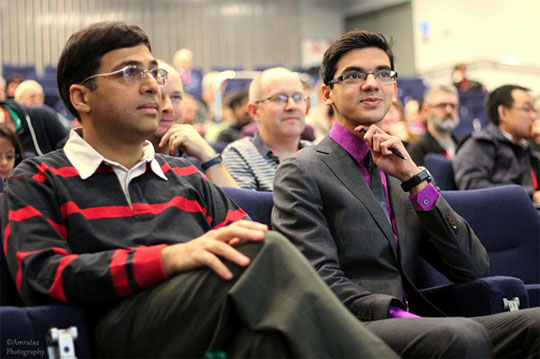
Before the start of the game: Anish in a snazzy shirt, blazer and tie, and Anand in his informal avatar

A loss yesterday didn’t seem to deter Veselin, who came to the second game in good spirits
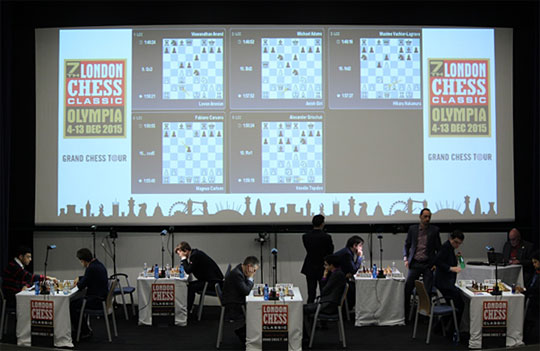
A few minutes into the game and the players had already started kibitzing
All of us, at some point or the other, have followed live games on the Internet. The excellent video coverage provided by elite events like Shamkir, Norway, London, etc. ensures that you get a near-to-being-present feeling at the venue. However, it is completely different to be seated in the auditorium and to witness the drama unfold in real life right in front of your eyes.

The game which everyone was looking forward to was definitely Carlsen against Caruana
Magnus played the relatively toothless 5.Re1 in the Berlin. But the game soon reached an exciting position, one where Caruana had to deal with the dangerous white passed pawn on d6. He managed to hold on to a draw, but only by a whisker.
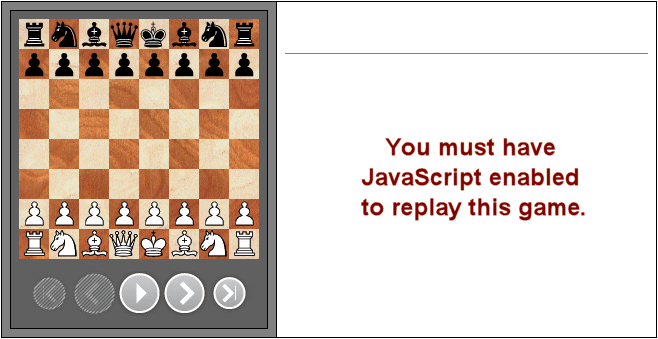
[Event "7th London Classic 2015"] [Site "London ENG"] [Date "2015.12.05"] [Round "2.4"] [White "Carlsen, Magnus"] [Black "Caruana, Fabiano"] [Result "1/2-1/2"] [ECO "C67"] [WhiteElo "2850"] [BlackElo "2787"] [Annotator "Sagar Shah"] [PlyCount "84"] [EventDate "2015.12.04"] 1. e4 e5 2. Nf3 Nc6 3. Bb5 Nf6 4. O-O Nxe4 5. Re1 {Magnus goes for a pretty sedate line, trying to get a small edge.} Nd6 6. Nxe5 Be7 7. Bf1 Nxe5 8. Rxe5 O-O 9. Nc3 Ne8 10. Nd5 Bd6 11. Re1 c6 12. Ne3 Be7 13. c4 Nc7 14. d4 d5 15. cxd5 Nxd5 16. Nxd5 cxd5 17. Bf4 {All of this has been seen before in the game Areshechenko-Bacrot in June 2015. White won that game. The position is very symmetrical. However, White seems to have a small edge due to better placement of his pieces, like the rook being on e1 and the bishop on f4. However, this is nothing much.} Bf6 18. Be5 Bxe5 19. Rxe5 {One of the reasons why White should have a small edge here is because the d5 pawn is on a light square, which means that the bishop on c8 is slightly a bad piece.} Re8 20. Rxe8+ Qxe8 21. Qb3 {Magnus was playing his moves pretty quickly and confidently.} Qc6 22. Bb5 Qb6 {Black is ready to sacrifice his d5 pawn in order to get some counterplay.} (22... Qd6 23. Rc1 (23. Re1 Be6 $11) 23... Be6 {also looks fine. But Caruana wanted to be more precise and hence chose Qb6 over Qd6.}) 23. Qxd5 a6 $1 {Very accurate.} (23... Be6 24. Qc5 $1 Qxc5 25. dxc5 $16 {is just an extra pawn.}) 24. Bd3 {Magnus retreats to a square where he can create some mating threats with Bd3.} Be6 25. Qe4 g6 26. d5 {It seems as if White has things going his way, but Caruana has everything under control.} Bf5 27. Qe2 Bxd3 28. Qxd3 Qxb2 {Black recovers the pawn. However, the d5 pawn is not at all a unit that should be underestimated.} 29. Re1 Rd8 30. d6 Rd7 {Stopping the pawn in the tracks. This is not all easy to defend but Caruana does a fine job.} (30... Qxa2 31. Qd4 $1 {looks pretty dangerous with Qf6 coming up next.}) 31. g3 $5 {Magnus takes out time to secure his back rank.} Qf6 32. Rd1 Qe5 33. Qa3 a5 34. f4 {This move might well be practically strong, however in the end it was this move that led to the perpetual check.} Qe2 35. Qc1 Qe6 36. Qc5 b5 37. Qxb5 (37. Qe5 $11 {Anand and Aronian analyzed this move in their press conference and it is also equal.}) 37... Rxd6 $1 {Caruana is tactically alert and sacrifices his rook in order to get a perpetual check.} 38. Qb8+ Kg7 39. Qxd6 Qe3+ 40. Kg2 Qe2+ 41. Kg1 Qe3+ 42. Kg2 Qe2+ 1/2-1/2
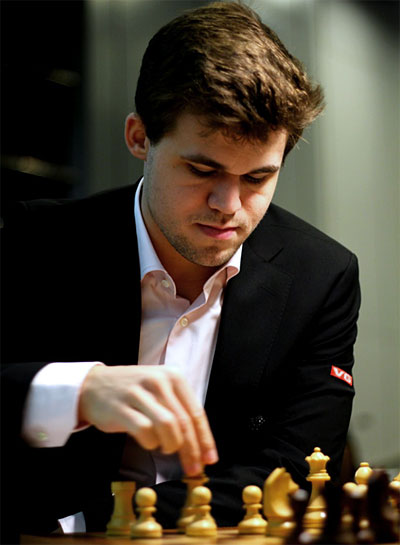
Magnus put some pressure on his opponent…

…but “Fabi” was up to the task!
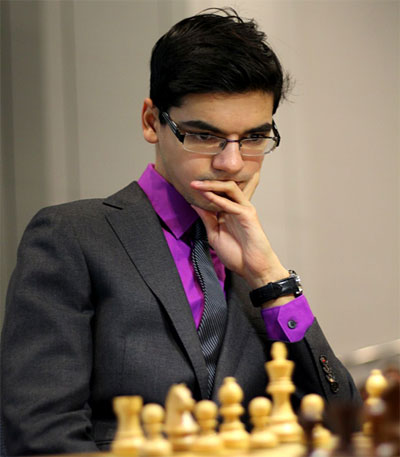
Overnight leader Anish Giri was playing quickly and moving around confidently on the stage…
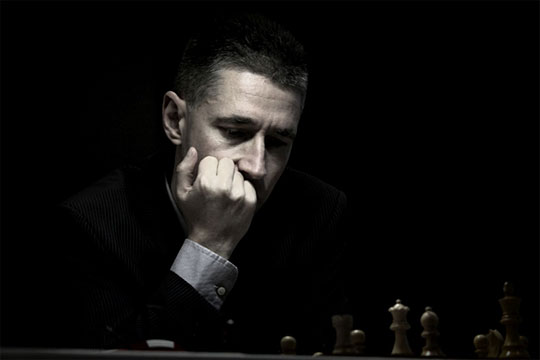
…but England’s Michael Adams gave him absolutely no winning chances

[Event "7th London Classic 2015"] [Site "London ENG"] [Date "2015.12.05"] [Round "2.2"] [White "Giri, Anish"] [Black "Adams, Michael"] [Result "1/2-1/2"] [ECO "E37"] [WhiteElo "2778"] [BlackElo "2744"] [Annotator "Sagar Shah"] [PlyCount "52"] [EventDate "2015.12.04"] 1. d4 Nf6 2. c4 e6 3. Nc3 Bb4 4. Qc2 d5 5. a3 Bxc3+ 6. Qxc3 Ne4 7. Qc2 c5 8. dxc5 Nc6 9. Nf3 Qa5+ 10. Bd2 Qxc5 11. e3 Nxd2 12. Nxd2 dxc4 13. Bxc4 O-O 14. b4 Qe7 15. Bd3 h6 16. Qc3 a6 17. O-O Bd7 18. Nc4 Rab8 19. Nb6 Rfd8 20. Rac1 Be8 21. Be4 {[#]} Na7 $1 {[%csl Gb5,Gc6][%cal Ge8c6,Ga7b5] You can bank on Michael Adams to find the most accurate way to equalize the game. The knight frees the c6 square for the e8 bishop, while at the same time it is also threaning to come to b5 with a tempo.} 22. a4 Qd6 23. Nc4 Qe7 24. Nb6 Qd6 25. Nc4 Qe7 26. Nb6 Qd6 {Optically it seems that White should be clearly better. But on close inspection you realize that Black is completely fine and the position is just equal.} 1/2-1/2

Veselin Topalov went on the scoreboard with a draw against Alexander Grischuk

A draw with black was not a bad result for Grischuk who found the nice Qb8-b4 maneuver

[Event "7th London Classic 2015"] [Site "London ENG"] [Date "2015.12.05"] [Round "2.5"] [White "Topalov, Veselin"] [Black "Grischuk, Alexander"] [Result "1/2-1/2"] [ECO "C65"] [WhiteElo "2803"] [BlackElo "2750"] [Annotator "Sagar Shah"] [PlyCount "65"] [EventDate "2015.12.04"] 1. e4 e5 2. Nf3 Nc6 3. Bb5 Nf6 4. d3 Bc5 5. c3 O-O 6. Nbd2 d6 7. h3 a6 8. Bxc6 bxc6 9. O-O Re8 10. Re1 h6 11. Nf1 Bb6 12. Ng3 Bd7 13. Be3 {I like this game because of Grischuk's imaginative activation of the queen.} Qb8 $1 {Just look how the queen comes in to the game.} 14. Qd2 Bxe3 15. Rxe3 a5 16. d4 exd4 17. cxd4 Qb4 $1 {[%cal Gd8b8,Gb8b4] After the queen exchange the position is equal. } 18. b3 Qxd2 19. Nxd2 a4 20. a3 axb3 21. Rxb3 Ra4 22. Rb7 Rxd4 23. Nf3 Ra4 24. Rxc7 Rc8 (24... Rd8 {the knight attacks the e4 pawn.} 25. e5 Ne8 26. Rb7 c5 27. exd6 Bc6 28. Rb3 Nxd6 $11 {is also round about equal.}) 25. Rxc8+ Bxc8 26. e5 dxe5 27. Nxe5 c5 28. Rc1 Rxa3 29. Rxc5 Be6 30. Rc1 Ra8 31. Nf3 Rc8 32. Rxc8+ Bxc8 33. Nd4 1/2-1/2
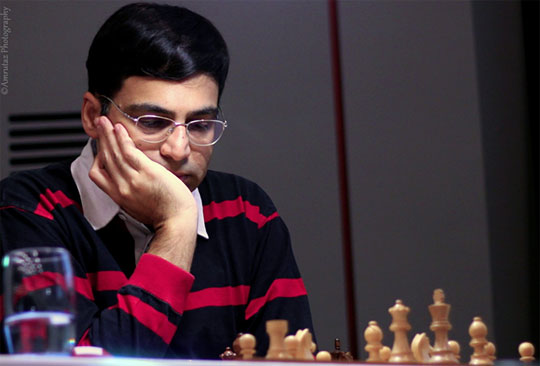
For a brief while Anand was under pressure
against Levon Aronian,
but after an inaccuracy by the Armenian the game ended in a draw

[Event "7th London Classic 2015"] [Site "London ENG"] [Date "2015.12.05"] [Round "2.1"] [White "Aronian, Levon"] [Black "Anand, Viswanathan"] [Result "1/2-1/2"] [ECO "D38"] [WhiteElo "2781"] [BlackElo "2803"] [Annotator "Sagar Shah"] [PlyCount "67"] [EventDate "2015.12.04"] 1. d4 Nf6 2. c4 e6 3. Nf3 d5 4. Nc3 Bb4 5. Bd2 O-O 6. e3 c5 7. a3 Bxc3 8. Bxc3 Ne4 9. Qc2 Nxc3 10. bxc3 Nd7 11. Bd3 h6 12. cxd5 exd5 13. Qb2 Qe7 14. O-O Nf6 15. Rfb1 c4 16. Bc2 Ne4 17. a4 Re8 18. a5 $1 {White has some pressure as the c8 bishop cannot be developed for the time being. However, Black can easily solve the problem either with Rb8 or, as Anand does in the game, Nd6.} Nd6 19. Qb4 Be6 20. Re1 $6 {Aronian would like to play e3-e4 but he removes the pressure from the b7 pawn. This helps Anand to exchange the key bishops.} (20. Ne5 {was much better keeping a minute edge.}) 20... Bf5 $1 21. Bxf5 Nxf5 { After this exchange the position is completely equal.} 22. Qxe7 Rxe7 23. h4 h5 24. g3 Nd6 25. Reb1 Rc8 26. Kg2 f6 27. Ng1 g5 28. Nf3 Ne4 29. Ra3 Rf8 30. Rb5 Rd7 31. Rb2 Rg7 32. Rb5 Rd7 33. Rb2 Rg7 34. Rb5 1/2-1/2
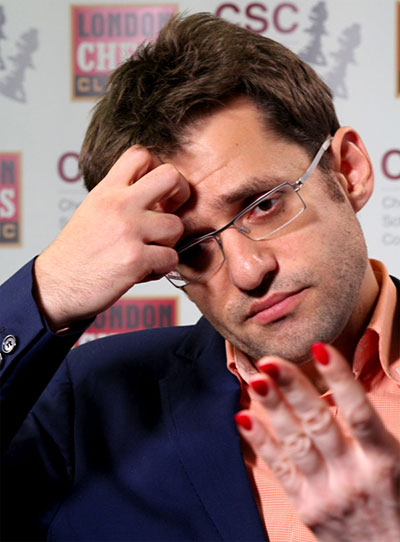
Aronian would have wanted to test Anand more with the position he had achieved out of the opening, but Re1 made the Indian player’s task quite easy. By the way do you see something unusual in the picture?

The hand with the red nail polish is, of course,
not Aronian’s! It belongs to
Jennifer Shahade who is doing a commendable job of interviewing of all the
elite players
The game of the day was surely the one between Hikaru Nakamura and Maxime Vachier-Lagrave. Nakamura’s unusual opening experiment fared pretty badly as he came out of the first phase with an inferior position, that too with the white pieces. Maxime played excellently and at one point had a clear win. However, he couldn’t find the critical continuation and the game petered out to equality.

[Event "7th London Classic 2015"] [Site "London ENG"] [Date "2015.12.05"] [Round "2.3"] [White "Nakamura, Hikaru"] [Black "Vachier-Lagrave, Maxime"] [Result "1/2-1/2"] [ECO "A48"] [WhiteElo "2793"] [BlackElo "2765"] [Annotator "Sagar Shah"] [PlyCount "113"] [EventDate "2015.12.04"] 1. d4 Nf6 2. Nf3 g6 3. e3 $5 {Nakamura plays something offbeat to get an original position.} Bg7 4. c4 O-O 5. Be2 {By not developing his knight on c3 White dissuades Black from playing the Grunfeld.} c5 (5... d5 6. cxd5 Nxd5 7. e4 {is considered pleasant for White.}) 6. d5 d6 7. Nc3 e6 8. O-O exd5 9. cxd5 {Now we are in Benoni territory where White has played the e3 Be2 line. Of course this is in no way theoretically threatening, especially because White will be a tempo down in the main lines when he has to go e3-e4. However, the position is still quite interesting and White can hope for a small edge.} Na6 10. Nd2 Rb8 11. e4 Re8 12. f3 Nh5 13. f4 Nf6 14. Kh1 Nc7 15. a4 a6 16. a5 Bd7 { Black has a very comfortable version of the Benoni. White's pieces are clumsily placed. Black can use the b5 square for his own pieces.} 17. Bf3 Nb5 18. e5 $6 dxe5 19. fxe5 Rxe5 $17 {Nakamura sacrifices a pawn to muddy the waters, but the position is just clearly better for Black.} 20. Nc4 Rf5 21. Ne2 Rxf3 $5 {A very interesting exchange sacrifice.} (21... Ng4 $1 22. Bxg4 Rxf1+ 23. Qxf1 Bxg4 $17 {was even stronger.}) 22. gxf3 Bh3 23. Re1 Qxd5 24. Nf4 Qxd1 25. Rxd1 {Black has two pawns for the exchange and excellent co-ordination.} Bd7 26. Be3 Bc6 27. Kg2 Re8 28. Kf2 g5 29. Nd3 g4 30. Nde5 Bd5 31. Rg1 h5 32. h3 {[#]} Bxc4 $6 (32... gxf3 $1 {would have lead to a winning position for Black but requires great deal of calculation.} 33. Bh6 Ne4+ $1 34. Ke3 (34. Kxf3 $2 Ng5+ $19) 34... Kh7 $1 35. Bxg7 f2 $1 36. Rg2 Nd4 $19 {and Black is a complete rook down, but with threats like Nc2+ he has a winning position. Of course this is not so easy to see during the game.}) 33. Nxc4 $11 {The worst is over for White.} Nd5 34. fxg4 Nxe3 35. Nxe3 Bxb2 36. Rae1 Bc3 37. Re2 Bd4 38. Kf3 Nc3 39. Ree1 Ne4 40. gxh5+ Kh7 41. Rg2 Nd6 42. Ree2 Re5 43. Nc2 Rxh5 44. Nxd4 cxd4 45. Rg4 Rxa5 46. Rxd4 Nf5 47. Rb4 b5 48. Kf4 Nh6 49. Ke5 Ra3 50. h4 Rg3 51. Ra2 Rg6 52. Rb1 Re6+ 53. Kf4 Rf6+ 54. Ke4 Re6+ 55. Kf4 Rf6+ 56. Ke4 Re6+ 57. Kf4 1/2-1/2
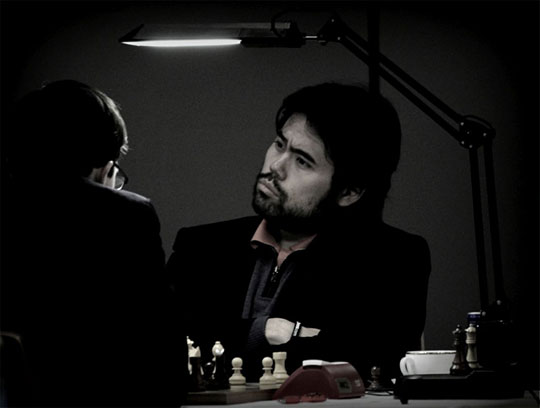
Nakamura had a grim day at the office, but he hung in there
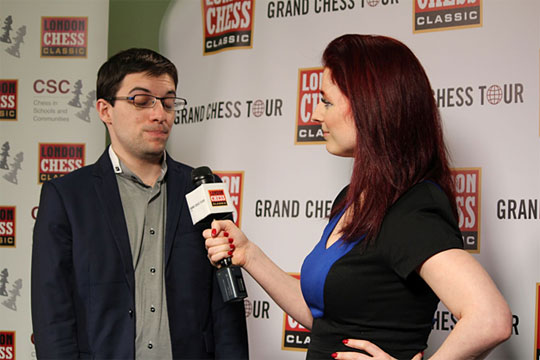
I was sooo close to winning, I just don’t know where I went wrong!
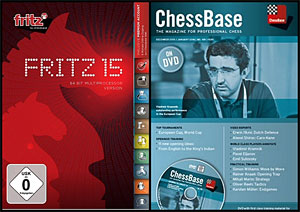
|
Game of the Day Round twoVeselin Topalov against Anish Giri was nominated game of the day for round one by readers and visitors. The lucky winner of the London Chess Classic poll is Lee Phillips. He wins a copy of Fritz 15 DVD, which will be delivered to him. |
We had a decisive result in the second game of the British Knockout Championships final between David Howell and Nick Pert. The game started with an English Opening that looked highly drawish. No pawns were exchanged until move 19, and by move 24 the players had reached a completely equal rook ending with seven pawns each. Well, the position was equal, not drawn. The finalists fought hard in the endgame trying to make use of every little resource available in the position. There were some nice themes of mutual zugzwang. Finally, Pert made a few errors and Howell scored the full point. He leads the match with a score of 1.5:0.5.
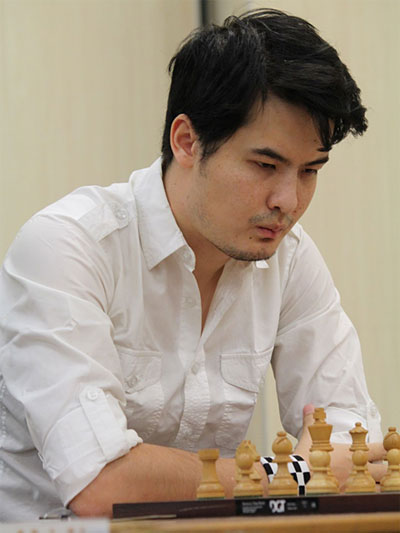
David Howell came in a fighting mood
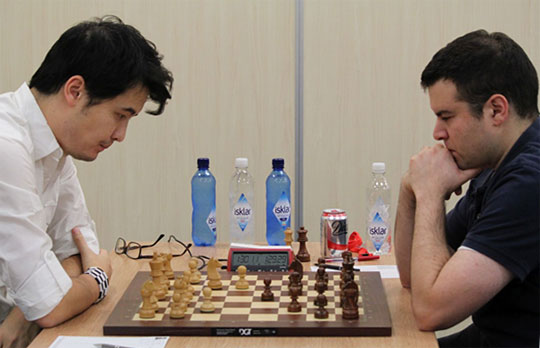
The game seemed to be hardly interesting out of the opening...
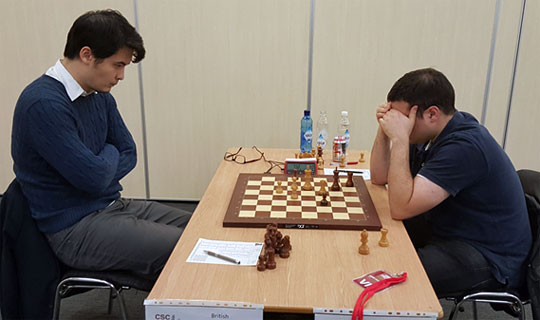
... but full credit to both the players for not agreeing to a draw and fighting right to the bitter end

[Event "British ch-KO 2015"] [Site "London ENG"] [Date "2015.12.06"] [Round "3.2"] [White "Howell, David W L"] [Black "Pert, Nicholas"] [Result "1-0"] [ECO "A26"] [WhiteElo "2693"] [BlackElo "2569"] [Annotator "Sagar Shah"] [PlyCount "105"] [EventDate "2015.12.01"] 1. c4 e5 2. Nc3 Nc6 3. g3 g6 4. Bg2 d6 5. d3 Bg7 6. e4 Nd4 7. Nce2 c5 8. Nxd4 cxd4 9. h4 h5 10. Nh3 Bh6 11. f4 Nf6 12. Nf2 Ng4 13. Nxg4 Bxg4 14. Bf3 Qd7 15. Bxg4 Qxg4 16. Qxg4 hxg4 17. O-O Ke7 18. a4 Rag8 19. Kg2 exf4 20. Bxf4 Bxf4 21. Rxf4 g5 22. hxg5 Rxg5 23. Rh1 Rxh1 24. Kxh1 a5 $11 {The position is just equal. } 25. Kg2 Ke6 26. Rf1 Rh5 27. Rf4 Rg5 28. Kf1 f6 29. Ke1 Rh5 30. Rxg4 Rh2 31. Rf4 Rxb2 32. Rf5 Rg2 33. Rd5 Rxg3 34. Rxd4 Rg5 35. Kd2 b6 36. Kc3 Rg1 37. Rd5 Rb1 38. Kd4 Rb4 $2 (38... Rb3 $1 39. Rb5 Rb4 $1 $11) 39. Rb5 $1 Rxa4 (39... Rxb5 40. cxb5 $18) 40. Rxb6 Rb4 {[#]} 41. Ra6 $6 (41. Rc6 $3 {A position of mutual zugzwang. If the rook leaves the fifth rank then c4-c5 becomes possible. And if the black king moves backwards, then the white king comes up.} Kd7 ( 41... a4 42. Ra6 $18) (41... Ra4 42. Ra6 $18) (41... Rb3 42. c5 $18) 42. Kd5 $18) 41... Ra4 42. Rb6 Rb4 43. Rc6 $1 {David Howell hits the right track.} a4 44. Ra6 Kd7 45. Kd5 $18 Kc7 46. Rxd6 Rb8 47. Kc5 a3 48. Rxf6 Kb7 49. Rf2 Ka6 50. Ra2 Rb3 51. d4 Ka5 52. d5 Ka4 53. d6 1-0
There were two rounds at the FIDE open today. After three games ten players are in joint lead with 3.0/3. Top seed Evegeny Postny of Israel scored two fine victories and so did Eric Hansen of Canada. A few of the higher rated players who aren’t playing up to par are Tigran Gharamiyan, Edouard Romain, Sergey Grigoriants and Rinat Jumabayev – all of them are on 2.0/3.
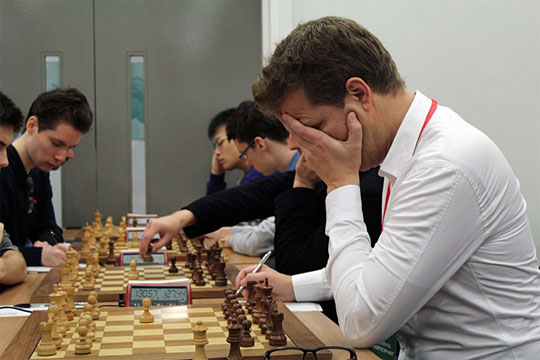
Oh my god, 1.c4. I cannot play the Modern Tiger!

On 3.0/3 is Canada’s Eric Hansen
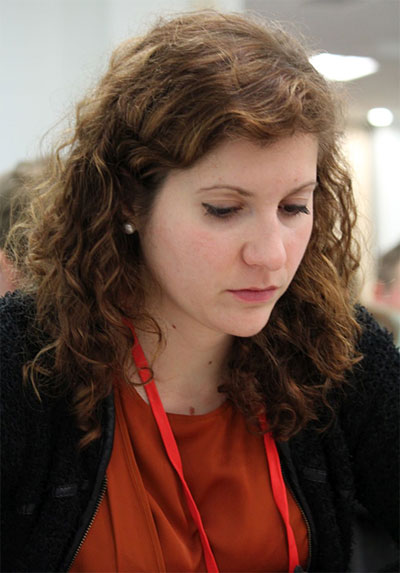
England’s leading female player Jovanka Houska is on 2.0/3
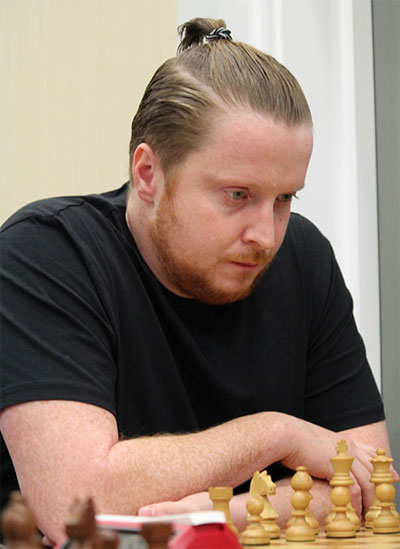
Some players, like the aggressive GM Simon Williams, sport a ponytail...

…while others do the same with a beard!
| Rk. | SNo | Ti. | Name | Rtg | Pts. |
| 1 | 1 | GM | Postny Evgeny | 2670 | 3,0 |
| 9 | GM | Hansen Eric | 2577 | 3,0 | |
| 13 | GM | Vakhidov Jahongir | 2546 | 3,0 | |
| 23 | GM | Arkell Keith Cc | 2490 | 3,0 | |
| 26 | IM | Swayams Mishra | 2477 | 3,0 | |
| 27 | IM | Andersen Mads | 2474 | 3,0 | |
| 28 | GM | Hebden Mark L | 2469 | 3,0 | |
| 33 | IM | Bartholomew John | 2443 | 3,0 | |
| 36 | IM | Sagar Shah | 2441 | 3,0 | |
| 51 | IM | Krishna Crg | 2367 | 3,0 |
Full results and standings here

Editorial note: IM Sagar Shah, who is writing these reports and at the same time playing the open section, has with gratuitous modesty neglected to mention that he too is on 3.0/3. He beat Andrew Harley (2226) and Vuilleumier Alexandre (2342) in rounds 2 and 3. He is on track to complete his third GM norm.
Before coming to London, Sagar spent a week at the ChessBase office in Hamburg, where his first DVD Learn from the Classics was released.
|
Photos by Amruta Mokal of ChessBase India
|
|
|||||||||||||||||||||||||||||||||||||
|
|
|||||||||||||||||||||||||||||||||||||
|
|
|||||||||||||||||||||||||||||||||||||
|
|
|||||||||||||||||||||||||||||||||||||
|
|
|||||||||||||||||||||||||||||||||||||
| Day and round | English | German |
| 04.12 Friday Round 1 | Merijn van Delft | Sebastian Siebrecht |
| 05.12 Saturday Round 2 | Oliver Reeh/Karsten Müller | Sebastian Siebrecht |
| 06.12 Sunday Round 3 | Merijn van Delft | Oliver Reeh/Karsten Müller |
| 07.12 Monday Round 4 | Merijn van Delft | Georgios Souleidis/Dorian Rogozenco |
| 08.12 Tuesday Round 5 | Merijn van Delft | Oliver Reeh/Dorian Rogozenco |
| 10.12 Thursday Round 6 | Merijn van Delft | Sebastian Siebrecht |
| 11.12 Friday Round 7 | Mihail Marin | Sebastian Siebrecht |
| 12.12 Saturday Round 8 | Georgios Souleidis/Oliver Reeh | Sebastian Siebrecht |
| 13.12 Sunday Round 9 | Yannick Pelletier | Oliver Reeh/Martin Breutigam |
Links
|